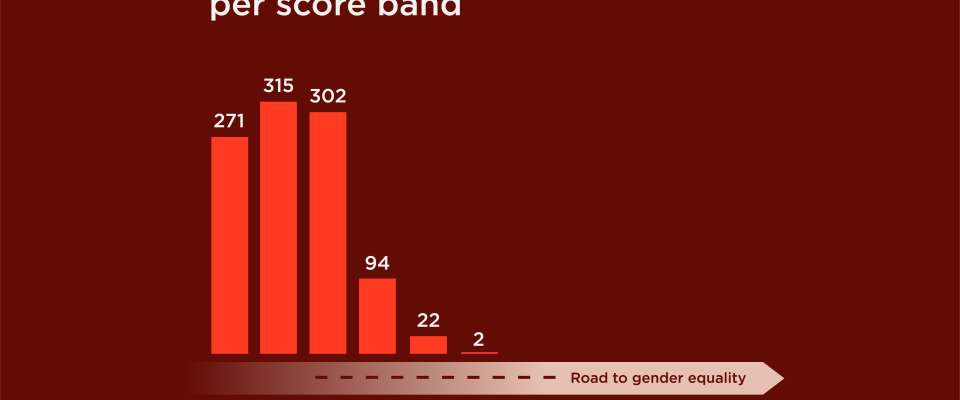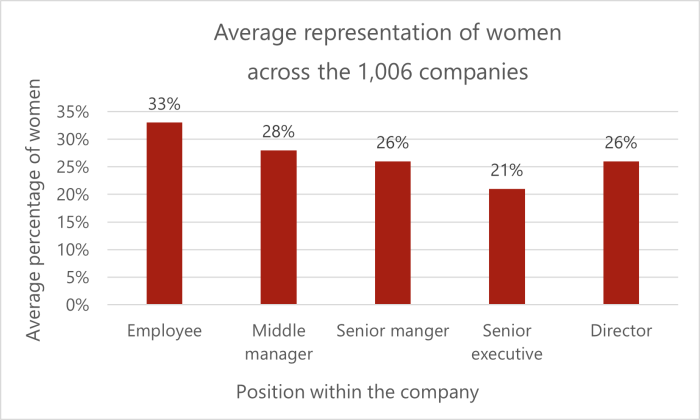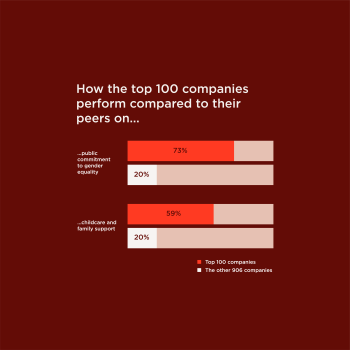Key finding
Performance on gender equality is dismal; in a majority of companies, women are underrepresented and their concerns unheard

Despite decades of efforts towards advancing gender equality in the workplace, our assessment of the 1,006 most influential companies globally shows that we still have a long way to go. Performance is grim, with companies scoring on average a mere 17%, and 123 companies (12%) scoring zero points, failing to demonstrate any corporate action to promote gender equality. Only two companies score slightly more than 50% of the total possible points, Eni and HPE.
Women’s representation in leadership has been one of the topics that has received most attention over the years, yet only three companies – Bristol Myers Squibb, Gap and Sodexo – have achieved gender balance (40–60%) at all levels of leadership: middle/other management, senior management, senior executives and board of directors. For the 747 companies that disclose this data, women are underrepresented in at least one level of leadership across 83% of companies and are underrepresented across all four levels of leadership for 44% of companies. Moreover, many women encounter a ‘broken rung’ at the beginning of the corporate ladder, with 66% of companies showing a decrease between proportion of women employees and those in middle management positions. This creates a weak pipeline and slows progress for women in managerial positions on their way to senior leadership. As a result, 72% of companies have senior management teams that reflect a smaller proportion of women than exists in their workforce.

The gap only gets wider in the C-suite, where on average women account for only 21% of senior executives, and 132 companies (13%) report that no women occupy these highest level positions responsible for company operations and profitability. While the overall average of women on the board of directors is slightly higher at 26%, likely due to nudges coming from legislation and other initiatives such as the 30% Club campaign, still 79 companies report having no women directors. When it comes to supply chains, the number of women represented in leadership is very opaque, with only three companies disclosing this information: Gap, Hennes & Mauritz (H&M) and VF Corporation.
Companies will face difficulties addressing the gender inequalities in their pipeline without more visibility into data that influence career progression, such as participation in career development programmes, promotion rates and absenteeism rates. Without these key metrics, companies have limited insights into why women are not advancing and, therefore, will have trouble creating equal opportunities.
Another obstacle which hinders companies’ performance in the assessment is their disconnect with employees’ experiences around topics such as discrimination, work-life balance, recognition and renumeration. Only 3% of companies have employee surveys or other engagement mechanisms that specifically inquire about matters related to gender equality. Furthermore, while 66% of companies have a grievance mechanism in place for employees to raise complaints or concerns related to the company, only two companies disclose that they monitor how many grievances are reported by women: Grupo Bimbo and Nan Ya Plastics Corporation. With the help of survey results and sex-disaggregated grievance data, companies would better understand systemic issues women face within the company.
This year marked the halfway point in the implementation of the Sustainable Development Goals, including Sustainable Development Goal 5 on Gender Equality, and we are still nowhere near the objectives set out in 2015. According to the World Economic Forum’s Global Gender Gap Report, it will take another 131 years to achieve gender parity. The private sector has a key role to play in accelerating progress, and some companies (see key finding two) have demonstrated that bold commitments and comprehensive action on gender equality are possible. However, unless companies fix their broken rungs to ensure that women have equal representation at the table as well as enquire about employees’ concerns, gender equality will remain out of reach.
